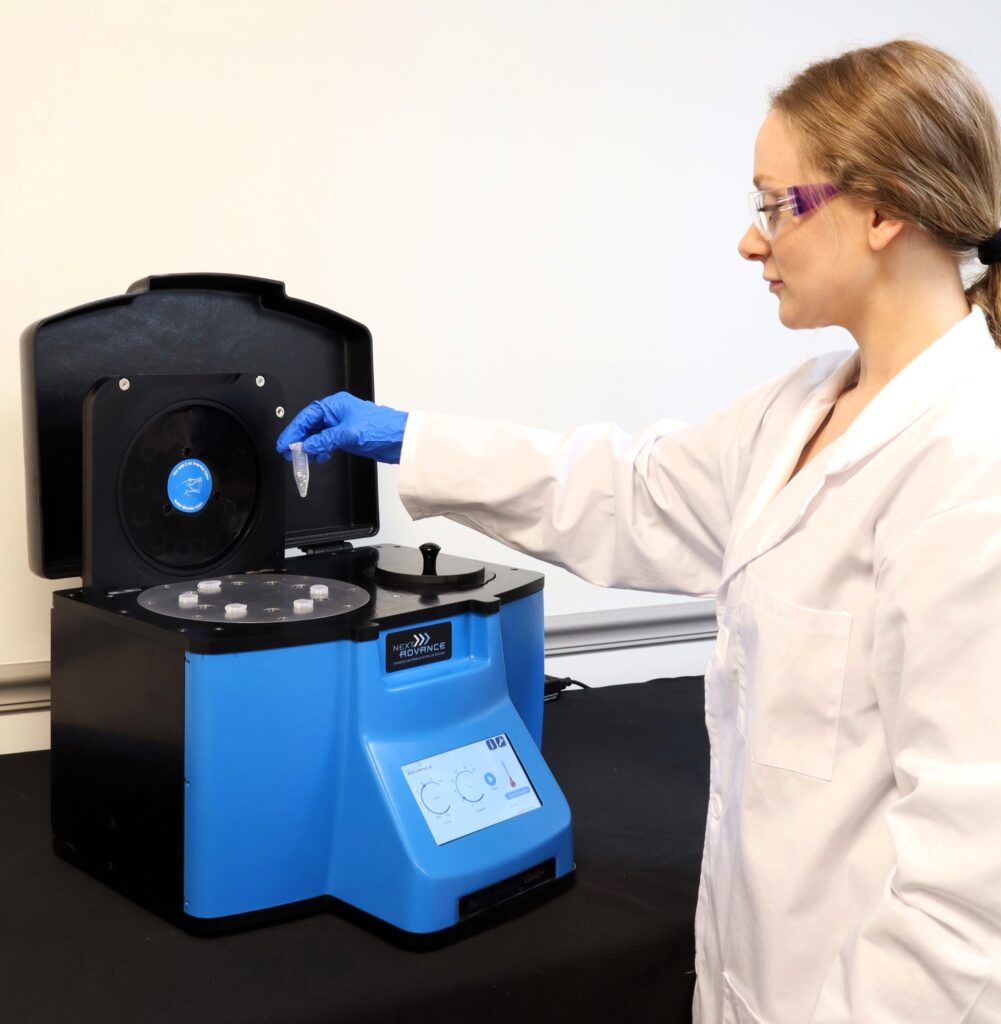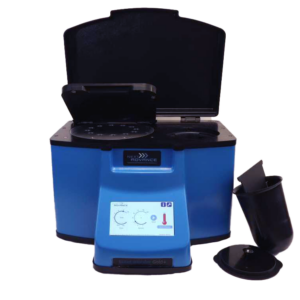Ideal for Plant Leaves Homogenization
Do you spend lots of time and effort homogenizing Plant leaf samples? The Bullet Blender® tissue homogenizer delivers high quality and superior yields. No other homogenizer comes close to delivering the Bullet Blender’s winning combination of top-quality performance and budget-friendly affordability. See below for a Plant tissue homogenization protocol.
Save Time, Effort and Get Superior Results with
The Bullet Blender Homogenizer
Consistent and High Yield Results
Run up to 24 samples at the same time under microprocessor-controlled conditions, ensuring experimental reproducibility and high yield. Process samples from 10mg or less up to 3.5g.No Cross Contamination
No part of the Bullet Blender ever touches the tissue – the sample tubes are kept closed during homogenization. There are no probes to clean between samples.Samples Stay Cool
The Bullet Blenders’ innovative and elegant design provides convective cooling of the samples, so they do not heat up more than several degrees. In fact, our Gold+ models hold the sample temperature to about 4ºC.Easy and Convenient to Use
Just place beads and buffer along with your tissue sample in standard tubes, load tubes directly in the Bullet Blender, select time and speed, and press start.Risk Free Purchase
Thousands of peer-reviewed journal articles attest to the consistency and quality of the Bullet Blender homogenizer. We offer a 2 year warranty, extendable to 4 years, because our Bullet Blenders are reliable and last for many years.Plant Homogenization Protocol
| Sample Tube | Protocol |
|---|---|
| 1.5 mL tubes | 1.5 mL tubes Leaf Protocol |
| 1.5/2 mL tubes in 5 mL adapters | 1.5/2 mL tubes in 5 mL adapters Leaf Protocol |
| 5 mL tubes | 5 mL tubes Leaf Protocol |
| 50 mL tubes | 50 mL tubes Leaf Protocol |
What Else Can You Homogenize? Tough or Soft, No Problem!
The Bullet Blender can process a wide range of samples including organ tissue, cell culture, plant tissue, and small organisms. You can homogenize samples as tough as mouse femur or for gentle applications such as tissue dissociation or organelle isolation.



Tomato plant leaf pieces (on beads in upper photo) are completely homogenized into the buffer (darker in lower photo).
Want more guidance? Need a quote? Contact us:

Bullet Blender Models
Select Publications using the Bullet Blender to Homogenize Plant Tissue
2474232
plants
1
apa
50
date
desc
3225
https://www.nextadvance.com/wp-content/plugins/zotpress/
%7B%22status%22%3A%22success%22%2C%22updateneeded%22%3Afalse%2C%22instance%22%3Afalse%2C%22meta%22%3A%7B%22request_last%22%3A0%2C%22request_next%22%3A0%2C%22used_cache%22%3Atrue%7D%2C%22data%22%3A%5B%7B%22key%22%3A%22LKCT9NIY%22%2C%22library%22%3A%7B%22id%22%3A2474232%7D%2C%22meta%22%3A%7B%22creatorSummary%22%3A%22Nguyen%20et%20al.%22%2C%22parsedDate%22%3A%222020-01-10%22%2C%22numChildren%22%3A1%7D%2C%22bib%22%3A%22%26lt%3Bdiv%20class%3D%26quot%3Bcsl-bib-body%26quot%3B%20style%3D%26quot%3Bline-height%3A%202%3B%20padding-left%3A%201em%3B%20text-indent%3A-1em%3B%26quot%3B%26gt%3B%5Cn%20%20%26lt%3Bdiv%20class%3D%26quot%3Bcsl-entry%26quot%3B%26gt%3BNguyen%2C%20H.%20M.%2C%20Yadav%2C%20N.%20S.%2C%20Barak%2C%20S.%2C%20Lima%2C%20F.%20P.%2C%20Sapir%2C%20Y.%2C%20%26amp%3B%20Winters%2C%20G.%20%282020%29.%20Responses%20of%20Invasive%20and%20Native%20Populations%20of%20the%20Seagrass%20Halophila%20stipulacea%20to%20Simulated%20Climate%20Change.%20%26lt%3Bi%26gt%3BFrontiers%20in%20Marine%20Science%26lt%3B%5C%2Fi%26gt%3B%2C%20%26lt%3Bi%26gt%3B6%26lt%3B%5C%2Fi%26gt%3B%2C%20812.%20%26lt%3Ba%20class%3D%26%23039%3Bzp-DOIURL%26%23039%3B%20href%3D%26%23039%3Bhttps%3A%5C%2F%5C%2Fdoi.org%5C%2F10.3389%5C%2Ffmars.2019.00812%26%23039%3B%26gt%3Bhttps%3A%5C%2F%5C%2Fdoi.org%5C%2F10.3389%5C%2Ffmars.2019.00812%26lt%3B%5C%2Fa%26gt%3B%26lt%3B%5C%2Fdiv%26gt%3B%5Cn%26lt%3B%5C%2Fdiv%26gt%3B%22%2C%22data%22%3A%7B%22itemType%22%3A%22journalArticle%22%2C%22title%22%3A%22Responses%20of%20Invasive%20and%20Native%20Populations%20of%20the%20Seagrass%20Halophila%20stipulacea%20to%20Simulated%20Climate%20Change%22%2C%22creators%22%3A%5B%7B%22creatorType%22%3A%22author%22%2C%22firstName%22%3A%22Hung%20Manh%22%2C%22lastName%22%3A%22Nguyen%22%7D%2C%7B%22creatorType%22%3A%22author%22%2C%22firstName%22%3A%22Narendra%20Singh%22%2C%22lastName%22%3A%22Yadav%22%7D%2C%7B%22creatorType%22%3A%22author%22%2C%22firstName%22%3A%22Simon%22%2C%22lastName%22%3A%22Barak%22%7D%2C%7B%22creatorType%22%3A%22author%22%2C%22firstName%22%3A%22Fernando%20P.%22%2C%22lastName%22%3A%22Lima%22%7D%2C%7B%22creatorType%22%3A%22author%22%2C%22firstName%22%3A%22Yuval%22%2C%22lastName%22%3A%22Sapir%22%7D%2C%7B%22creatorType%22%3A%22author%22%2C%22firstName%22%3A%22Gidon%22%2C%22lastName%22%3A%22Winters%22%7D%5D%2C%22abstractNote%22%3A%22%22%2C%22date%22%3A%222020-1-10%22%2C%22language%22%3A%22%22%2C%22DOI%22%3A%2210.3389%5C%2Ffmars.2019.00812%22%2C%22ISSN%22%3A%222296-7745%22%2C%22url%22%3A%22https%3A%5C%2F%5C%2Fwww.frontiersin.org%5C%2Farticle%5C%2F10.3389%5C%2Ffmars.2019.00812%5C%2Ffull%22%2C%22collections%22%3A%5B%22M2MNG549%22%5D%2C%22dateModified%22%3A%222020-01-24T18%3A06%3A14Z%22%7D%7D%2C%7B%22key%22%3A%2299NHABT6%22%2C%22library%22%3A%7B%22id%22%3A2474232%7D%2C%22meta%22%3A%7B%22creatorSummary%22%3A%22Diamos%20et%20al.%22%2C%22parsedDate%22%3A%222016-02-24%22%2C%22numChildren%22%3A2%7D%2C%22bib%22%3A%22%26lt%3Bdiv%20class%3D%26quot%3Bcsl-bib-body%26quot%3B%20style%3D%26quot%3Bline-height%3A%202%3B%20padding-left%3A%201em%3B%20text-indent%3A-1em%3B%26quot%3B%26gt%3B%5Cn%20%20%26lt%3Bdiv%20class%3D%26quot%3Bcsl-entry%26quot%3B%26gt%3BDiamos%2C%20A.%20G.%2C%20Rosenthal%2C%20S.%20H.%2C%20%26amp%3B%20Mason%2C%20H.%20S.%20%282016%29.%205%26%23x2032%3B%20and%203%26%23x2032%3B%20Untranslated%20Regions%20Strongly%20Enhance%20Performance%20of%20Geminiviral%20Replicons%20in%20Nicotiana%20benthamiana%20Leaves.%20%26lt%3Bi%26gt%3BFrontiers%20in%20Plant%20Science%26lt%3B%5C%2Fi%26gt%3B%2C%20%26lt%3Bi%26gt%3B7%26lt%3B%5C%2Fi%26gt%3B.%20%26lt%3Ba%20class%3D%26%23039%3Bzp-DOIURL%26%23039%3B%20href%3D%26%23039%3Bhttps%3A%5C%2F%5C%2Fdoi.org%5C%2F10.3389%5C%2Ffpls.2016.00200%26%23039%3B%26gt%3Bhttps%3A%5C%2F%5C%2Fdoi.org%5C%2F10.3389%5C%2Ffpls.2016.00200%26lt%3B%5C%2Fa%26gt%3B%26lt%3B%5C%2Fdiv%26gt%3B%5Cn%26lt%3B%5C%2Fdiv%26gt%3B%22%2C%22data%22%3A%7B%22itemType%22%3A%22journalArticle%22%2C%22title%22%3A%225%5Cu2032%20and%203%5Cu2032%20Untranslated%20Regions%20Strongly%20Enhance%20Performance%20of%20Geminiviral%20Replicons%20in%20Nicotiana%20benthamiana%20Leaves%22%2C%22creators%22%3A%5B%7B%22creatorType%22%3A%22author%22%2C%22firstName%22%3A%22Andrew%20G.%22%2C%22lastName%22%3A%22Diamos%22%7D%2C%7B%22creatorType%22%3A%22author%22%2C%22firstName%22%3A%22Sun%20H.%22%2C%22lastName%22%3A%22Rosenthal%22%7D%2C%7B%22creatorType%22%3A%22author%22%2C%22firstName%22%3A%22Hugh%20S.%22%2C%22lastName%22%3A%22Mason%22%7D%5D%2C%22abstractNote%22%3A%22We%20previously%20reported%20a%20recombinant%20protein%20production%20system%20based%20on%20a%20geminivirus%20replicon%20that%20yields%20high%20levels%20of%20vaccine%20antigens%20and%20monoclonal%20antibodies%20in%20plants.%20The%20bean%20yellow%20dwarf%20virus%20%28BeYDV%29%20replicon%20generates%20massive%20amounts%20of%20DNA%20copies%2C%20which%20engage%20the%20plant%20transcription%20machinery.%20However%2C%20we%20noticed%20a%20disparity%20between%20transcript%20level%20and%20protein%20production%2C%20suggesting%20that%20mRNAs%20could%20be%20more%20efficiently%20utilized.%20In%20this%20study%2C%20we%20systematically%20evaluated%20genetic%20elements%20from%20human%2C%20viral%2C%20and%20plant%20sources%20for%20their%20potential%20to%20improve%20the%20BeYDV%20system.%20The%20tobacco%20extensin%20terminator%20enhanced%20transcript%20accumulation%20and%20protein%20production%20compared%20to%20other%20commonly%20used%20terminators%2C%20indicating%20that%20efficient%20transcript%20processing%20plays%20an%20important%20role%20in%20recombinant%20protein%20production.%20Evaluation%20of%20human-derived%205%5Cu2032%20untranslated%20regions%20%28UTRs%29%20indicated%20that%20many%20provided%20high%20levels%20of%20protein%20production%2C%20supporting%20their%20cross-kingdom%20function.%20Among%20the%20viral%205%5Cu2032%20UTRs%20tested%2C%20we%20found%20the%20greatest%20enhancement%20with%20the%20tobacco%20mosaic%20virus%20omega%20leader.%20An%20analysis%20of%20the%205%5Cu2032%20UTRs%20from%20the%20Arabidopsis%20thaliana%20and%20Nicotinana%20benthamiana%20photosystem%20I%20K%20genes%20found%20that%20they%20were%20highly%20active%20when%20truncated%20to%20include%20only%20the%20near%20upstream%20region%2C%20providing%20a%20dramatic%20enhancement%20of%20transgene%20production%20that%20exceeded%20that%20of%20the%20tobacco%20mosaic%20virus%20omega%20leader.%20The%20tobacco%20Rb7%20matrix%20attachment%20region%20inserted%20downstream%20from%20the%20gene%20of%20interest%20provided%20significant%20enhancement%2C%20which%20was%20correlated%20with%20a%20reduction%20in%20plant%20cell%20death.%20Evaluation%20of%20Agrobacterium%20strains%20found%20that%20EHA105%20enhanced%20protein%20production%20and%20reduced%20cell%20death%20compared%20to%20LBA4301%20and%20GV3101.%20We%20used%20these%20improvements%20to%20produce%20Norwalk%20virus%20capsid%20protein%20at%20%26gt%3B20%25%20total%20soluble%20protein%2C%20corresponding%20to%201.8%20mg%5C%2Fg%20leaf%20fresh%20weight%2C%20more%20than%20twice%20the%20highest%20level%20ever%20reported%20in%20a%20plant%20system.%20We%20also%20produced%20the%20monoclonal%20antibody%20rituximab%20at%201%20mg%5C%2Fg%20leaf%20fresh%20weight.%22%2C%22date%22%3A%222016-2-24%22%2C%22language%22%3A%22%22%2C%22DOI%22%3A%2210.3389%5C%2Ffpls.2016.00200%22%2C%22ISSN%22%3A%221664-462X%22%2C%22url%22%3A%22http%3A%5C%2F%5C%2Fwww.ncbi.nlm.nih.gov%5C%2Fpmc%5C%2Farticles%5C%2FPMC4764687%5C%2F%22%2C%22collections%22%3A%5B%22M2MNG549%22%5D%2C%22dateModified%22%3A%222016-06-10T19%3A12%3A42Z%22%7D%7D%2C%7B%22key%22%3A%22UMX4VBPQ%22%2C%22library%22%3A%7B%22id%22%3A2474232%7D%2C%22meta%22%3A%7B%22creatorSummary%22%3A%22Riga%20et%20al.%22%2C%22parsedDate%22%3A%222016%22%2C%22numChildren%22%3A0%7D%2C%22bib%22%3A%22%26lt%3Bdiv%20class%3D%26quot%3Bcsl-bib-body%26quot%3B%20style%3D%26quot%3Bline-height%3A%202%3B%20padding-left%3A%201em%3B%20text-indent%3A-1em%3B%26quot%3B%26gt%3B%5Cn%20%20%26lt%3Bdiv%20class%3D%26quot%3Bcsl-entry%26quot%3B%26gt%3BRiga%2C%20P.%2C%20Benedicto%2C%20L.%2C%20Garc%26%23xED%3Ba-Flores%2C%20L.%2C%20Villa%26%23xF1%3Bo%2C%20D.%2C%20Medina%2C%20S.%2C%20%26amp%3B%20Gil-Izquierdo%2C%20%26%23xC1%3B.%20%282016%29.%20Rootstock%20effect%20on%20serotonin%20and%20nutritional%20quality%20of%20tomatoes%20produced%20under%20low%20temperature%20and%20light%20conditions.%20%26lt%3Bi%26gt%3BJournal%20of%20Food%20Composition%20and%20Analysis%26lt%3B%5C%2Fi%26gt%3B%2C%20%26lt%3Bi%26gt%3B46%26lt%3B%5C%2Fi%26gt%3B%2C%2050%26%23x2013%3B59.%20%26lt%3Ba%20class%3D%26%23039%3Bzp-DOIURL%26%23039%3B%20href%3D%26%23039%3Bhttps%3A%5C%2F%5C%2Fdoi.org%5C%2F10.1016%5C%2Fj.jfca.2015.11.003%26%23039%3B%26gt%3Bhttps%3A%5C%2F%5C%2Fdoi.org%5C%2F10.1016%5C%2Fj.jfca.2015.11.003%26lt%3B%5C%2Fa%26gt%3B%26lt%3B%5C%2Fdiv%26gt%3B%5Cn%26lt%3B%5C%2Fdiv%26gt%3B%22%2C%22data%22%3A%7B%22itemType%22%3A%22journalArticle%22%2C%22title%22%3A%22Rootstock%20effect%20on%20serotonin%20and%20nutritional%20quality%20of%20tomatoes%20produced%20under%20low%20temperature%20and%20light%20conditions%22%2C%22creators%22%3A%5B%7B%22creatorType%22%3A%22author%22%2C%22firstName%22%3A%22Patrick%22%2C%22lastName%22%3A%22Riga%22%7D%2C%7B%22creatorType%22%3A%22author%22%2C%22firstName%22%3A%22Leyre%22%2C%22lastName%22%3A%22Benedicto%22%7D%2C%7B%22creatorType%22%3A%22author%22%2C%22firstName%22%3A%22Libia%22%2C%22lastName%22%3A%22Garc%5Cu00eda-Flores%22%7D%2C%7B%22creatorType%22%3A%22author%22%2C%22firstName%22%3A%22D%5Cu00e9bora%22%2C%22lastName%22%3A%22Villa%5Cu00f1o%22%7D%2C%7B%22creatorType%22%3A%22author%22%2C%22firstName%22%3A%22Sonia%22%2C%22lastName%22%3A%22Medina%22%7D%2C%7B%22creatorType%22%3A%22author%22%2C%22firstName%22%3A%22%5Cu00c1ngel%22%2C%22lastName%22%3A%22Gil-Izquierdo%22%7D%5D%2C%22abstractNote%22%3A%22%22%2C%22date%22%3A%2203%5C%2F2016%22%2C%22language%22%3A%22en%22%2C%22DOI%22%3A%2210.1016%5C%2Fj.jfca.2015.11.003%22%2C%22ISSN%22%3A%2208891575%22%2C%22url%22%3A%22http%3A%5C%2F%5C%2Flinkinghub.elsevier.com%5C%2Fretrieve%5C%2Fpii%5C%2FS088915751500246X%22%2C%22collections%22%3A%5B%22M2MNG549%22%5D%2C%22dateModified%22%3A%222015-12-30T15%3A47%3A08Z%22%7D%7D%2C%7B%22key%22%3A%22J4C5MZKU%22%2C%22library%22%3A%7B%22id%22%3A2474232%7D%2C%22meta%22%3A%7B%22creatorSummary%22%3A%22Davis%20et%20al.%22%2C%22parsedDate%22%3A%222015-09-30%22%2C%22numChildren%22%3A0%7D%2C%22bib%22%3A%22%26lt%3Bdiv%20class%3D%26quot%3Bcsl-bib-body%26quot%3B%20style%3D%26quot%3Bline-height%3A%202%3B%20padding-left%3A%201em%3B%20text-indent%3A-1em%3B%26quot%3B%26gt%3B%5Cn%20%20%26lt%3Bdiv%20class%3D%26quot%3Bcsl-entry%26quot%3B%26gt%3BDavis%2C%20T.%20S.%2C%20Bosque-P%26%23xE9%3Brez%2C%20N.%20A.%2C%20Popova%2C%20I.%2C%20%26amp%3B%20Eigenbrode%2C%20S.%20D.%20%282015%29.%20Evidence%20for%20additive%20effects%20of%20virus%20infection%20and%20water%20availability%20on%20phytohormone%20induction%20in%20a%20staple%20crop.%20%26lt%3Bi%26gt%3BFrontiers%20in%20Ecology%20and%20Evolution%26lt%3B%5C%2Fi%26gt%3B%2C%20%26lt%3Bi%26gt%3B3%26lt%3B%5C%2Fi%26gt%3B.%20%26lt%3Ba%20class%3D%26%23039%3Bzp-DOIURL%26%23039%3B%20href%3D%26%23039%3Bhttps%3A%5C%2F%5C%2Fdoi.org%5C%2F10.3389%5C%2Ffevo.2015.00114%26%23039%3B%26gt%3Bhttps%3A%5C%2F%5C%2Fdoi.org%5C%2F10.3389%5C%2Ffevo.2015.00114%26lt%3B%5C%2Fa%26gt%3B%26lt%3B%5C%2Fdiv%26gt%3B%5Cn%26lt%3B%5C%2Fdiv%26gt%3B%22%2C%22data%22%3A%7B%22itemType%22%3A%22journalArticle%22%2C%22title%22%3A%22Evidence%20for%20additive%20effects%20of%20virus%20infection%20and%20water%20availability%20on%20phytohormone%20induction%20in%20a%20staple%20crop%22%2C%22creators%22%3A%5B%7B%22creatorType%22%3A%22author%22%2C%22firstName%22%3A%22Thomas%20S.%22%2C%22lastName%22%3A%22Davis%22%7D%2C%7B%22creatorType%22%3A%22author%22%2C%22firstName%22%3A%22Nilsa%20A.%22%2C%22lastName%22%3A%22Bosque-P%5Cu00e9rez%22%7D%2C%7B%22creatorType%22%3A%22author%22%2C%22firstName%22%3A%22Ina%22%2C%22lastName%22%3A%22Popova%22%7D%2C%7B%22creatorType%22%3A%22author%22%2C%22firstName%22%3A%22Sanford%20D.%22%2C%22lastName%22%3A%22Eigenbrode%22%7D%5D%2C%22abstractNote%22%3A%22%22%2C%22date%22%3A%222015-09-30%22%2C%22language%22%3A%22%22%2C%22DOI%22%3A%2210.3389%5C%2Ffevo.2015.00114%22%2C%22ISSN%22%3A%222296-701X%22%2C%22url%22%3A%22http%3A%5C%2F%5C%2Fjournal.frontiersin.org%5C%2FArticle%5C%2F10.3389%5C%2Ffevo.2015.00114%5C%2Fabstract%22%2C%22collections%22%3A%5B%22M2MNG549%22%5D%2C%22dateModified%22%3A%222015-12-30T20%3A31%3A03Z%22%7D%7D%2C%7B%22key%22%3A%228I26UEGI%22%2C%22library%22%3A%7B%22id%22%3A2474232%7D%2C%22meta%22%3A%7B%22creatorSummary%22%3A%22Mohammad%22%2C%22parsedDate%22%3A%222015-04-15%22%2C%22numChildren%22%3A0%7D%2C%22bib%22%3A%22%26lt%3Bdiv%20class%3D%26quot%3Bcsl-bib-body%26quot%3B%20style%3D%26quot%3Bline-height%3A%202%3B%20padding-left%3A%201em%3B%20text-indent%3A-1em%3B%26quot%3B%26gt%3B%5Cn%20%20%26lt%3Bdiv%20class%3D%26quot%3Bcsl-entry%26quot%3B%26gt%3BMohammad%2C%20A.-I.%20A.%20%282015%29.%20Electrophoretic%20analysis%20of%20proteins%20from%20different%20date%26%23xA0%3B%20palm%26%23xA0%3B%20%28Phoenix%20dactylifera%20L.%29%20cultivars%20in%20Saudi%20Arabia.%20%26lt%3Bi%26gt%3BAfrican%20Journal%20of%20Biotechnology%26lt%3B%5C%2Fi%26gt%3B%2C%20%26lt%3Bi%26gt%3B14%26lt%3B%5C%2Fi%26gt%3B%2815%29%2C%201325%26%23x2013%3B1333.%20%26lt%3Ba%20class%3D%26%23039%3Bzp-DOIURL%26%23039%3B%20href%3D%26%23039%3Bhttps%3A%5C%2F%5C%2Fdoi.org%5C%2F10.5897%5C%2FAJB2014.14398%26%23039%3B%26gt%3Bhttps%3A%5C%2F%5C%2Fdoi.org%5C%2F10.5897%5C%2FAJB2014.14398%26lt%3B%5C%2Fa%26gt%3B%26lt%3B%5C%2Fdiv%26gt%3B%5Cn%26lt%3B%5C%2Fdiv%26gt%3B%22%2C%22data%22%3A%7B%22itemType%22%3A%22journalArticle%22%2C%22title%22%3A%22Electrophoretic%20analysis%20of%20proteins%20from%20different%20date%20%20palm%20%20%28Phoenix%20dactylifera%20L.%29%20cultivars%20in%20Saudi%20Arabia%22%2C%22creators%22%3A%5B%7B%22creatorType%22%3A%22author%22%2C%22firstName%22%3A%22Al%20-%20Issa%20Adil%22%2C%22lastName%22%3A%22Mohammad%22%7D%5D%2C%22abstractNote%22%3A%22Fifteen%20%5Cn%2815%29%20%5Cnsamples%20of%20different%20date%20palm%20cultivars%20were%20collected%20from%20different%20locations%20in%20Al%5Cn-%5CnAhsa%20%5Cnoasis%20in%20the%20eastern%20province%20of%20Saudi%20Arabia.%20Extracted%20proteins%20from%20these%20samples%20were%20analyzed%20by%20%5Cnelectrophoresis%2C%20and%20clustered%20according%20to%20the%20average%20linkage%20between%20groups%20hierarchical%20clustering%20%5Cnmethod.%20The%20results%20reveal%20high%20degree%20of%20simi%5Cnlarity%20based%20on%20Jaccard%60s%20similarity%20method%20on%20the%20basis%20%5Cnof%20%20presence%20%20and%20%20absence%20%20of%20%20bands%2C%20%20that%20%20ranged%20%20between%20%200.421%20%20to%20%200.917%2C%20%20which%20%20was%20%20represented%20%20by%20%5Cnphylogenetic%20%20dendrogram%20%20in%20%20six%20%20clusters.%20%20The%20%20closely%20%20related%20%20cultivars%20%20%26quot%3BHel%26quot%3B%20%20and%20%20%26quot%3BHat%26quot%3B%20%20in%20%20addition%20%20to%20%5Cn%26quot%3BK%5Cnhl%26quot%3B%20represent%20the%20sixth%20cluster%2C%20which%20is%20separated%20out%20of%20other%20cultivars%20with%20high%20degree%20of%20similarity%20%5Cnthat%20ranged%20between%200.636%20to%200.714%3B%20it%20was%20confirmed%20by%20the%20first%20principal%20component%20with%20high%20loading%20%5Cn%2852.3%25%29%2C%20%20and%20%20characterized%20%20by%20%20four%20%20bands%20%20%2892%2C%20%5Cn100%2C%20%20205%20%20and%20%20108%20%20kda%29.%20%20These%20%20bands%20%20were%20%20mostly%20%5Cnpositioned%20close%20to%20each%20other%20in%20the%20scatter%20diagram.%20The%20second%20principal%20component%20with%20loading%20of%20%5Cn15.7%25%2C%20which%20were%20represented%20by%20three%20bands%2019%2C%2025%2C%20and%2037%20kda%2C%20have%20been%20confirmed%20the%20first%20cluster%20%5Cnof%20%20c%5Cnlosely%20%20related%20%20cultivars%20%20%26quot%3BShi%26quot%3B%20%20and%20%20%26quot%3BShl%26quot%3B%2C%20%20as%20%20well%20%20as%20%20the%20%20closely%20%20related%20%20cultivars%20%20%26quot%3BMj%26quot%3B%20%20and%20%20%26quot%3BOmR%26quot%3B%20%5Cnamong%20%20the%20%20second%20%20cluster.%20%20It%20%20can%20%20be%20%20concluded%20%20that%20%20most%20%20of%20%20Al%5Cn-%5CnAhsa%20%20oasis%20%20date%20%20palm%20%20cultivars%20%20were%20%5Cnfrom%20%20one%20%20genetic%20%20origin%2C%20%20however%2C%20%20each%20%20cultivar%20%20was%20%20grown%20%20fr%5Cnom%20%20seed%20%20of%20%20locally%20%20known%20%20cultivar%2C%20%20and%20%5Cnlater%20was%20selected%20due%20to%20preferred%20fruit%20characteristics.%20More%20biochemical%20and%20molecular%20studies%20would%20%5Cnbe%20necessary%20to%20uncover%20the%20genetic%20relationships%20between%20area%20cultivars.%22%2C%22date%22%3A%2215%20April%202015%22%2C%22language%22%3A%22%22%2C%22DOI%22%3A%2210.5897%5C%2FAJB2014.14398%22%2C%22ISSN%22%3A%22%22%2C%22url%22%3A%22http%3A%5C%2F%5C%2Fwww.ajol.info%5C%2Findex.php%5C%2Fajb%5C%2Farticle%5C%2Fview%5C%2F116747%5C%2F106323%22%2C%22collections%22%3A%5B%22M2MNG549%22%5D%2C%22dateModified%22%3A%222015-08-06T15%3A52%3A33Z%22%7D%7D%2C%7B%22key%22%3A%22KBBHB5CG%22%2C%22library%22%3A%7B%22id%22%3A2474232%7D%2C%22meta%22%3A%7B%22creatorSummary%22%3A%22Tierno%20et%20al.%22%2C%22parsedDate%22%3A%222015%22%2C%22numChildren%22%3A0%7D%2C%22bib%22%3A%22%26lt%3Bdiv%20class%3D%26quot%3Bcsl-bib-body%26quot%3B%20style%3D%26quot%3Bline-height%3A%202%3B%20padding-left%3A%201em%3B%20text-indent%3A-1em%3B%26quot%3B%26gt%3B%5Cn%20%20%26lt%3Bdiv%20class%3D%26quot%3Bcsl-entry%26quot%3B%26gt%3BTierno%2C%20R.%2C%20L%26%23xF3%3Bpez%2C%20A.%2C%20Riga%2C%20P.%2C%20Arazuri%2C%20S.%2C%20Jar%26%23xE9%3Bn%2C%20C.%2C%20Benedicto%2C%20L.%2C%20%26amp%3B%20Ruiz%20de%20Galarreta%2C%20J.%20I.%20%282015%29.%20Phytochemicals%20determination%20and%20classification%20in%20purple%20and%20red%20fleshed%20potato%20tubers%20by%20analytical%20methods%20and%20near%20infrared%20spectroscopy%3A%20Phytochemicals%20in%20potato%20tubers.%20%26lt%3Bi%26gt%3BJournal%20of%20the%20Science%20of%20Food%20and%20Agriculture%26lt%3B%5C%2Fi%26gt%3B%2C%20n%5C%2Fa-n%5C%2Fa.%20%26lt%3Ba%20class%3D%26%23039%3Bzp-DOIURL%26%23039%3B%20href%3D%26%23039%3Bhttps%3A%5C%2F%5C%2Fdoi.org%5C%2F10.1002%5C%2Fjsfa.7294%26%23039%3B%26gt%3Bhttps%3A%5C%2F%5C%2Fdoi.org%5C%2F10.1002%5C%2Fjsfa.7294%26lt%3B%5C%2Fa%26gt%3B%26lt%3B%5C%2Fdiv%26gt%3B%5Cn%26lt%3B%5C%2Fdiv%26gt%3B%22%2C%22data%22%3A%7B%22itemType%22%3A%22journalArticle%22%2C%22title%22%3A%22Phytochemicals%20determination%20and%20classification%20in%20purple%20and%20red%20fleshed%20potato%20tubers%20by%20analytical%20methods%20and%20near%20infrared%20spectroscopy%3A%20Phytochemicals%20in%20potato%20tubers%22%2C%22creators%22%3A%5B%7B%22creatorType%22%3A%22author%22%2C%22firstName%22%3A%22Roberto%22%2C%22lastName%22%3A%22Tierno%22%7D%2C%7B%22creatorType%22%3A%22author%22%2C%22firstName%22%3A%22Ainara%22%2C%22lastName%22%3A%22L%5Cu00f3pez%22%7D%2C%7B%22creatorType%22%3A%22author%22%2C%22firstName%22%3A%22Patrick%22%2C%22lastName%22%3A%22Riga%22%7D%2C%7B%22creatorType%22%3A%22author%22%2C%22firstName%22%3A%22Silvia%22%2C%22lastName%22%3A%22Arazuri%22%7D%2C%7B%22creatorType%22%3A%22author%22%2C%22firstName%22%3A%22Carmen%22%2C%22lastName%22%3A%22Jar%5Cu00e9n%22%7D%2C%7B%22creatorType%22%3A%22author%22%2C%22firstName%22%3A%22Leire%22%2C%22lastName%22%3A%22Benedicto%22%7D%2C%7B%22creatorType%22%3A%22author%22%2C%22firstName%22%3A%22Jos%5Cu00e9%20I%22%2C%22lastName%22%3A%22Ruiz%20de%20Galarreta%22%7D%5D%2C%22abstractNote%22%3A%22%22%2C%22date%22%3A%2207%5C%2F2015%22%2C%22language%22%3A%22en%22%2C%22DOI%22%3A%2210.1002%5C%2Fjsfa.7294%22%2C%22ISSN%22%3A%2200225142%22%2C%22url%22%3A%22http%3A%5C%2F%5C%2Fdoi.wiley.com%5C%2F10.1002%5C%2Fjsfa.7294%22%2C%22collections%22%3A%5B%22M2MNG549%22%5D%2C%22dateModified%22%3A%222015-08-10T15%3A51%3A25Z%22%7D%7D%2C%7B%22key%22%3A%22ES98BIII%22%2C%22library%22%3A%7B%22id%22%3A2474232%7D%2C%22meta%22%3A%7B%22creatorSummary%22%3A%22Kraaijeveld%20et%20al.%22%2C%22parsedDate%22%3A%222015%22%2C%22numChildren%22%3A0%7D%2C%22bib%22%3A%22%26lt%3Bdiv%20class%3D%26quot%3Bcsl-bib-body%26quot%3B%20style%3D%26quot%3Bline-height%3A%202%3B%20padding-left%3A%201em%3B%20text-indent%3A-1em%3B%26quot%3B%26gt%3B%5Cn%20%20%26lt%3Bdiv%20class%3D%26quot%3Bcsl-entry%26quot%3B%26gt%3BKraaijeveld%2C%20K.%2C%20de%20Weger%2C%20L.%20A.%2C%20Ventayol%20Garc%26%23xED%3Ba%2C%20M.%2C%20Buermans%2C%20H.%2C%20Frank%2C%20J.%2C%20Hiemstra%2C%20P.%20S.%2C%20%26amp%3B%20den%20Dunnen%2C%20J.%20T.%20%282015%29.%20Efficient%20and%20sensitive%20identification%20and%20quantification%20of%20airborne%20pollen%20using%20next-generation%20DNA%20sequencing.%20%26lt%3Bi%26gt%3BMolecular%20Ecology%20Resources%26lt%3B%5C%2Fi%26gt%3B%2C%20%26lt%3Bi%26gt%3B15%26lt%3B%5C%2Fi%26gt%3B%281%29%2C%208%26%23x2013%3B16.%20%26lt%3Ba%20class%3D%26%23039%3Bzp-DOIURL%26%23039%3B%20href%3D%26%23039%3Bhttps%3A%5C%2F%5C%2Fdoi.org%5C%2F10.1111%5C%2F1755-0998.12288%26%23039%3B%26gt%3Bhttps%3A%5C%2F%5C%2Fdoi.org%5C%2F10.1111%5C%2F1755-0998.12288%26lt%3B%5C%2Fa%26gt%3B%26lt%3B%5C%2Fdiv%26gt%3B%5Cn%26lt%3B%5C%2Fdiv%26gt%3B%22%2C%22data%22%3A%7B%22itemType%22%3A%22journalArticle%22%2C%22title%22%3A%22Efficient%20and%20sensitive%20identification%20and%20quantification%20of%20airborne%20pollen%20using%20next-generation%20DNA%20sequencing%22%2C%22creators%22%3A%5B%7B%22creatorType%22%3A%22author%22%2C%22firstName%22%3A%22Ken%22%2C%22lastName%22%3A%22Kraaijeveld%22%7D%2C%7B%22creatorType%22%3A%22author%22%2C%22firstName%22%3A%22Letty%20A.%22%2C%22lastName%22%3A%22de%20Weger%22%7D%2C%7B%22creatorType%22%3A%22author%22%2C%22firstName%22%3A%22Marina%22%2C%22lastName%22%3A%22Ventayol%20Garc%5Cu00eda%22%7D%2C%7B%22creatorType%22%3A%22author%22%2C%22firstName%22%3A%22Henk%22%2C%22lastName%22%3A%22Buermans%22%7D%2C%7B%22creatorType%22%3A%22author%22%2C%22firstName%22%3A%22Jeroen%22%2C%22lastName%22%3A%22Frank%22%7D%2C%7B%22creatorType%22%3A%22author%22%2C%22firstName%22%3A%22Pieter%20S.%22%2C%22lastName%22%3A%22Hiemstra%22%7D%2C%7B%22creatorType%22%3A%22author%22%2C%22firstName%22%3A%22Johan%20T.%22%2C%22lastName%22%3A%22den%20Dunnen%22%7D%5D%2C%22abstractNote%22%3A%22%22%2C%22date%22%3A%2201%5C%2F2015%22%2C%22language%22%3A%22en%22%2C%22DOI%22%3A%2210.1111%5C%2F1755-0998.12288%22%2C%22ISSN%22%3A%221755098X%22%2C%22url%22%3A%22http%3A%5C%2F%5C%2Fdoi.wiley.com%5C%2F10.1111%5C%2F1755-0998.12288%22%2C%22collections%22%3A%5B%22M2MNG549%22%5D%2C%22dateModified%22%3A%222015-07-31T17%3A29%3A35Z%22%7D%7D%2C%7B%22key%22%3A%225DGRTT9W%22%2C%22library%22%3A%7B%22id%22%3A2474232%7D%2C%22meta%22%3A%7B%22creatorSummary%22%3A%22Mora%20et%20al.%22%2C%22parsedDate%22%3A%222014-09-15%22%2C%22numChildren%22%3A0%7D%2C%22bib%22%3A%22%26lt%3Bdiv%20class%3D%26quot%3Bcsl-bib-body%26quot%3B%20style%3D%26quot%3Bline-height%3A%202%3B%20padding-left%3A%201em%3B%20text-indent%3A-1em%3B%26quot%3B%26gt%3B%5Cn%20%20%26lt%3Bdiv%20class%3D%26quot%3Bcsl-entry%26quot%3B%26gt%3BMora%2C%20Y.%2C%20Diaz%2C%20R.%2C%20Vargas-Lagunas%2C%20C.%2C%20Peralta%2C%20H.%2C%20Guerrero%2C%20G.%2C%20Aguilar%2C%20A.%2C%20Encarnacion%2C%20S.%2C%20Girard%2C%20L.%2C%20%26amp%3B%20Mora%2C%20J.%20%282014%29.%20Nitrogen-Fixing%20Rhizobial%20Strains%20Isolated%20from%20Common%20Bean%20Seeds%3A%20Phylogeny%2C%20Physiology%2C%20and%20Genome%20Analysis.%20%26lt%3Bi%26gt%3BApplied%20and%20Environmental%20Microbiology%26lt%3B%5C%2Fi%26gt%3B%2C%20%26lt%3Bi%26gt%3B80%26lt%3B%5C%2Fi%26gt%3B%2818%29%2C%205644%26%23x2013%3B5654.%20%26lt%3Ba%20class%3D%26%23039%3Bzp-DOIURL%26%23039%3B%20href%3D%26%23039%3Bhttps%3A%5C%2F%5C%2Fdoi.org%5C%2F10.1128%5C%2FAEM.01491-14%26%23039%3B%26gt%3Bhttps%3A%5C%2F%5C%2Fdoi.org%5C%2F10.1128%5C%2FAEM.01491-14%26lt%3B%5C%2Fa%26gt%3B%26lt%3B%5C%2Fdiv%26gt%3B%5Cn%26lt%3B%5C%2Fdiv%26gt%3B%22%2C%22data%22%3A%7B%22itemType%22%3A%22journalArticle%22%2C%22title%22%3A%22Nitrogen-Fixing%20Rhizobial%20Strains%20Isolated%20from%20Common%20Bean%20Seeds%3A%20Phylogeny%2C%20Physiology%2C%20and%20Genome%20Analysis%22%2C%22creators%22%3A%5B%7B%22creatorType%22%3A%22author%22%2C%22firstName%22%3A%22Y.%22%2C%22lastName%22%3A%22Mora%22%7D%2C%7B%22creatorType%22%3A%22author%22%2C%22firstName%22%3A%22R.%22%2C%22lastName%22%3A%22Diaz%22%7D%2C%7B%22creatorType%22%3A%22author%22%2C%22firstName%22%3A%22C.%22%2C%22lastName%22%3A%22Vargas-Lagunas%22%7D%2C%7B%22creatorType%22%3A%22author%22%2C%22firstName%22%3A%22H.%22%2C%22lastName%22%3A%22Peralta%22%7D%2C%7B%22creatorType%22%3A%22author%22%2C%22firstName%22%3A%22G.%22%2C%22lastName%22%3A%22Guerrero%22%7D%2C%7B%22creatorType%22%3A%22author%22%2C%22firstName%22%3A%22A.%22%2C%22lastName%22%3A%22Aguilar%22%7D%2C%7B%22creatorType%22%3A%22author%22%2C%22firstName%22%3A%22S.%22%2C%22lastName%22%3A%22Encarnacion%22%7D%2C%7B%22creatorType%22%3A%22author%22%2C%22firstName%22%3A%22L.%22%2C%22lastName%22%3A%22Girard%22%7D%2C%7B%22creatorType%22%3A%22author%22%2C%22firstName%22%3A%22J.%22%2C%22lastName%22%3A%22Mora%22%7D%5D%2C%22abstractNote%22%3A%22%22%2C%22date%22%3A%222014-09-15%22%2C%22language%22%3A%22en%22%2C%22DOI%22%3A%2210.1128%5C%2FAEM.01491-14%22%2C%22ISSN%22%3A%220099-2240%2C%201098-5336%22%2C%22url%22%3A%22http%3A%5C%2F%5C%2Faem.asm.org%5C%2Fcgi%5C%2Fdoi%5C%2F10.1128%5C%2FAEM.01491-14%22%2C%22collections%22%3A%5B%22M2MNG549%22%5D%2C%22dateModified%22%3A%222016-01-12T18%3A46%3A26Z%22%7D%7D%2C%7B%22key%22%3A%22NAKN3A7U%22%2C%22library%22%3A%7B%22id%22%3A2474232%7D%2C%22meta%22%3A%7B%22creatorSummary%22%3A%22Devanathan%20et%20al.%22%2C%22parsedDate%22%3A%222014-04-23%22%2C%22numChildren%22%3A0%7D%2C%22bib%22%3A%22%26lt%3Bdiv%20class%3D%26quot%3Bcsl-bib-body%26quot%3B%20style%3D%26quot%3Bline-height%3A%202%3B%20padding-left%3A%201em%3B%20text-indent%3A-1em%3B%26quot%3B%26gt%3B%5Cn%20%20%26lt%3Bdiv%20class%3D%26quot%3Bcsl-entry%26quot%3B%26gt%3BDevanathan%2C%20S.%2C%20Erban%2C%20A.%2C%20Perez-Torres%2C%20R.%2C%20Kopka%2C%20J.%2C%20%26amp%3B%20Makaroff%2C%20C.%20A.%20%282014%29.%20Arabidopsis%20thaliana%20Glyoxalase%202-1%20Is%20Required%20during%20Abiotic%20Stress%20but%20Is%20Not%20Essential%20under%20Normal%20Plant%20Growth.%20%26lt%3Bi%26gt%3BPLoS%20ONE%26lt%3B%5C%2Fi%26gt%3B%2C%20%26lt%3Bi%26gt%3B9%26lt%3B%5C%2Fi%26gt%3B%284%29%2C%20e95971.%20%26lt%3Ba%20class%3D%26%23039%3Bzp-DOIURL%26%23039%3B%20href%3D%26%23039%3Bhttps%3A%5C%2F%5C%2Fdoi.org%5C%2F10.1371%5C%2Fjournal.pone.0095971%26%23039%3B%26gt%3Bhttps%3A%5C%2F%5C%2Fdoi.org%5C%2F10.1371%5C%2Fjournal.pone.0095971%26lt%3B%5C%2Fa%26gt%3B%26lt%3B%5C%2Fdiv%26gt%3B%5Cn%26lt%3B%5C%2Fdiv%26gt%3B%22%2C%22data%22%3A%7B%22itemType%22%3A%22journalArticle%22%2C%22title%22%3A%22Arabidopsis%20thaliana%20Glyoxalase%202-1%20Is%20Required%20during%20Abiotic%20Stress%20but%20Is%20Not%20Essential%20under%20Normal%20Plant%20Growth%22%2C%22creators%22%3A%5B%7B%22creatorType%22%3A%22author%22%2C%22firstName%22%3A%22Sriram%22%2C%22lastName%22%3A%22Devanathan%22%7D%2C%7B%22creatorType%22%3A%22author%22%2C%22firstName%22%3A%22Alexander%22%2C%22lastName%22%3A%22Erban%22%7D%2C%7B%22creatorType%22%3A%22author%22%2C%22firstName%22%3A%22Rodolfo%22%2C%22lastName%22%3A%22Perez-Torres%22%7D%2C%7B%22creatorType%22%3A%22author%22%2C%22firstName%22%3A%22Joachim%22%2C%22lastName%22%3A%22Kopka%22%7D%2C%7B%22creatorType%22%3A%22author%22%2C%22firstName%22%3A%22Christopher%20A.%22%2C%22lastName%22%3A%22Makaroff%22%7D%2C%7B%22creatorType%22%3A%22editor%22%2C%22firstName%22%3A%22Haibing%22%2C%22lastName%22%3A%22Yang%22%7D%5D%2C%22abstractNote%22%3A%22%22%2C%22date%22%3A%222014-4-23%22%2C%22language%22%3A%22en%22%2C%22DOI%22%3A%2210.1371%5C%2Fjournal.pone.0095971%22%2C%22ISSN%22%3A%221932-6203%22%2C%22url%22%3A%22http%3A%5C%2F%5C%2Fdx.plos.org%5C%2F10.1371%5C%2Fjournal.pone.0095971%22%2C%22collections%22%3A%5B%22M2MNG549%22%5D%2C%22dateModified%22%3A%222015-10-30T19%3A56%3A10Z%22%7D%7D%2C%7B%22key%22%3A%22G4JWBTEW%22%2C%22library%22%3A%7B%22id%22%3A2474232%7D%2C%22meta%22%3A%7B%22creatorSummary%22%3A%22Riga%20et%20al.%22%2C%22parsedDate%22%3A%222014%22%2C%22numChildren%22%3A0%7D%2C%22bib%22%3A%22%26lt%3Bdiv%20class%3D%26quot%3Bcsl-bib-body%26quot%3B%20style%3D%26quot%3Bline-height%3A%202%3B%20padding-left%3A%201em%3B%20text-indent%3A-1em%3B%26quot%3B%26gt%3B%5Cn%20%20%26lt%3Bdiv%20class%3D%26quot%3Bcsl-entry%26quot%3B%26gt%3BRiga%2C%20P.%2C%20Medina%2C%20S.%2C%20Garc%26%23xED%3Ba-Flores%2C%20L.%20A.%2C%20%26amp%3B%20Gil-Izquierdo%2C%20%26%23xC1%3B.%20%282014%29.%20Melatonin%20content%20of%20pepper%20and%20tomato%20fruits%3A%20Effects%20of%20cultivar%20and%20solar%20radiation.%20%26lt%3Bi%26gt%3BFood%20Chemistry%26lt%3B%5C%2Fi%26gt%3B%2C%20%26lt%3Bi%26gt%3B156%26lt%3B%5C%2Fi%26gt%3B%2C%20347%26%23x2013%3B352.%20%26lt%3Ba%20class%3D%26%23039%3Bzp-DOIURL%26%23039%3B%20href%3D%26%23039%3Bhttps%3A%5C%2F%5C%2Fdoi.org%5C%2F10.1016%5C%2Fj.foodchem.2014.01.117%26%23039%3B%26gt%3Bhttps%3A%5C%2F%5C%2Fdoi.org%5C%2F10.1016%5C%2Fj.foodchem.2014.01.117%26lt%3B%5C%2Fa%26gt%3B%26lt%3B%5C%2Fdiv%26gt%3B%5Cn%26lt%3B%5C%2Fdiv%26gt%3B%22%2C%22data%22%3A%7B%22itemType%22%3A%22journalArticle%22%2C%22title%22%3A%22Melatonin%20content%20of%20pepper%20and%20tomato%20fruits%3A%20Effects%20of%20cultivar%20and%20solar%20radiation%22%2C%22creators%22%3A%5B%7B%22creatorType%22%3A%22author%22%2C%22firstName%22%3A%22Patrick%22%2C%22lastName%22%3A%22Riga%22%7D%2C%7B%22creatorType%22%3A%22author%22%2C%22firstName%22%3A%22Sonia%22%2C%22lastName%22%3A%22Medina%22%7D%2C%7B%22creatorType%22%3A%22author%22%2C%22firstName%22%3A%22Libia%20Alejandra%22%2C%22lastName%22%3A%22Garc%5Cu00eda-Flores%22%7D%2C%7B%22creatorType%22%3A%22author%22%2C%22firstName%22%3A%22%5Cu00c1ngel%22%2C%22lastName%22%3A%22Gil-Izquierdo%22%7D%5D%2C%22abstractNote%22%3A%22%22%2C%22date%22%3A%2208%5C%2F2014%22%2C%22language%22%3A%22en%22%2C%22DOI%22%3A%2210.1016%5C%2Fj.foodchem.2014.01.117%22%2C%22ISSN%22%3A%2203088146%22%2C%22url%22%3A%22http%3A%5C%2F%5C%2Flinkinghub.elsevier.com%5C%2Fretrieve%5C%2Fpii%5C%2FS0308814614001599%22%2C%22collections%22%3A%5B%22M2MNG549%22%5D%2C%22dateModified%22%3A%222015-08-05T13%3A15%3A13Z%22%7D%7D%2C%7B%22key%22%3A%22XZKU2M8T%22%2C%22library%22%3A%7B%22id%22%3A2474232%7D%2C%22meta%22%3A%7B%22creatorSummary%22%3A%22Shen%20et%20al.%22%2C%22parsedDate%22%3A%222014%22%2C%22numChildren%22%3A0%7D%2C%22bib%22%3A%22%26lt%3Bdiv%20class%3D%26quot%3Bcsl-bib-body%26quot%3B%20style%3D%26quot%3Bline-height%3A%202%3B%20padding-left%3A%201em%3B%20text-indent%3A-1em%3B%26quot%3B%26gt%3B%5Cn%20%20%26lt%3Bdiv%20class%3D%26quot%3Bcsl-entry%26quot%3B%26gt%3BShen%2C%20Y.-H.%2C%20Chen%2C%20Y.-H.%2C%20Liu%2C%20H.-Y.%2C%20Chiang%2C%20F.-Y.%2C%20Wang%2C%20Y.-C.%2C%20Hou%2C%20L.-Y.%2C%20Lin%2C%20J.-S.%2C%20Lin%2C%20C.-C.%2C%20Lin%2C%20H.-H.%2C%20Lai%2C%20H.-M.%2C%20%26amp%3B%20Jeng%2C%20S.-T.%20%282014%29.%20Expression%20of%20a%20gene%20encoding%20%26%23x3B2%3B-ureidopropionase%20is%20critical%20for%20pollen%20germination%20in%20tomatoes.%20%26lt%3Bi%26gt%3BPhysiologia%20Plantarum%26lt%3B%5C%2Fi%26gt%3B%2C%20%26lt%3Bi%26gt%3B150%26lt%3B%5C%2Fi%26gt%3B%283%29%2C%20425%26%23x2013%3B435.%20%26lt%3Ba%20class%3D%26%23039%3Bzp-DOIURL%26%23039%3B%20href%3D%26%23039%3Bhttps%3A%5C%2F%5C%2Fdoi.org%5C%2F10.1111%5C%2Fppl.12085%26%23039%3B%26gt%3Bhttps%3A%5C%2F%5C%2Fdoi.org%5C%2F10.1111%5C%2Fppl.12085%26lt%3B%5C%2Fa%26gt%3B%26lt%3B%5C%2Fdiv%26gt%3B%5Cn%26lt%3B%5C%2Fdiv%26gt%3B%22%2C%22data%22%3A%7B%22itemType%22%3A%22journalArticle%22%2C%22title%22%3A%22Expression%20of%20a%20gene%20encoding%20%5Cu03b2-ureidopropionase%20is%20critical%20for%20pollen%20germination%20in%20tomatoes%22%2C%22creators%22%3A%5B%7B%22creatorType%22%3A%22author%22%2C%22firstName%22%3A%22Yu-Hsing%22%2C%22lastName%22%3A%22Shen%22%7D%2C%7B%22creatorType%22%3A%22author%22%2C%22firstName%22%3A%22Yu-Huei%22%2C%22lastName%22%3A%22Chen%22%7D%2C%7B%22creatorType%22%3A%22author%22%2C%22firstName%22%3A%22Hao-Yun%22%2C%22lastName%22%3A%22Liu%22%7D%2C%7B%22creatorType%22%3A%22author%22%2C%22firstName%22%3A%22Fang-Yi%22%2C%22lastName%22%3A%22Chiang%22%7D%2C%7B%22creatorType%22%3A%22author%22%2C%22firstName%22%3A%22Yi-Chieh%22%2C%22lastName%22%3A%22Wang%22%7D%2C%7B%22creatorType%22%3A%22author%22%2C%22firstName%22%3A%22Liang-Yu%22%2C%22lastName%22%3A%22Hou%22%7D%2C%7B%22creatorType%22%3A%22author%22%2C%22firstName%22%3A%22Jeng-Shane%22%2C%22lastName%22%3A%22Lin%22%7D%2C%7B%22creatorType%22%3A%22author%22%2C%22firstName%22%3A%22Chih-Ching%22%2C%22lastName%22%3A%22Lin%22%7D%2C%7B%22creatorType%22%3A%22author%22%2C%22firstName%22%3A%22Hsin-Hung%22%2C%22lastName%22%3A%22Lin%22%7D%2C%7B%22creatorType%22%3A%22author%22%2C%22firstName%22%3A%22Hsi-Mei%22%2C%22lastName%22%3A%22Lai%22%7D%2C%7B%22creatorType%22%3A%22author%22%2C%22firstName%22%3A%22Shih-Tong%22%2C%22lastName%22%3A%22Jeng%22%7D%5D%2C%22abstractNote%22%3A%22%22%2C%22date%22%3A%2203%5C%2F2014%22%2C%22language%22%3A%22en%22%2C%22DOI%22%3A%2210.1111%5C%2Fppl.12085%22%2C%22ISSN%22%3A%2200319317%22%2C%22url%22%3A%22http%3A%5C%2F%5C%2Fdoi.wiley.com%5C%2F10.1111%5C%2Fppl.12085%22%2C%22collections%22%3A%5B%22M2MNG549%22%5D%2C%22dateModified%22%3A%222015-10-30T20%3A39%3A52Z%22%7D%7D%2C%7B%22key%22%3A%227VFMMCHM%22%2C%22library%22%3A%7B%22id%22%3A2474232%7D%2C%22meta%22%3A%7B%22creatorSummary%22%3A%22Mohammad%22%2C%22parsedDate%22%3A%222013-04-01%22%2C%22numChildren%22%3A0%7D%2C%22bib%22%3A%22%26lt%3Bdiv%20class%3D%26quot%3Bcsl-bib-body%26quot%3B%20style%3D%26quot%3Bline-height%3A%202%3B%20padding-left%3A%201em%3B%20text-indent%3A-1em%3B%26quot%3B%26gt%3B%5Cn%20%20%26lt%3Bdiv%20class%3D%26quot%3Bcsl-entry%26quot%3B%26gt%3BMohammad.%20%282013%29.%20ELECTROPHORETIC%20ANALYSIS%20OF%20PROTEIN%20PATTERNS%20IN%20DATE%20PALM%20%26%23x201C%3BKHALAS%26%23x201D%3B%20CULTIVAR%20LEAFLETS%20AMONG%20DIFFERENT%20LOCATIONS%20OF%20AL-AHSA.%20%26lt%3Bi%26gt%3BAmerican%20Journal%20of%20Agricultural%20and%20Biological%20Sciences%26lt%3B%5C%2Fi%26gt%3B%2C%20%26lt%3Bi%26gt%3B8%26lt%3B%5C%2Fi%26gt%3B%284%29%2C%20343%26%23x2013%3B349.%20%26lt%3Ba%20class%3D%26%23039%3Bzp-DOIURL%26%23039%3B%20href%3D%26%23039%3Bhttps%3A%5C%2F%5C%2Fdoi.org%5C%2F10.3844%5C%2Fajabssp.2013.343.349%26%23039%3B%26gt%3Bhttps%3A%5C%2F%5C%2Fdoi.org%5C%2F10.3844%5C%2Fajabssp.2013.343.349%26lt%3B%5C%2Fa%26gt%3B%26lt%3B%5C%2Fdiv%26gt%3B%5Cn%26lt%3B%5C%2Fdiv%26gt%3B%22%2C%22data%22%3A%7B%22itemType%22%3A%22journalArticle%22%2C%22title%22%3A%22ELECTROPHORETIC%20ANALYSIS%20OF%20PROTEIN%20PATTERNS%20IN%20DATE%20PALM%20%5Cu201cKHALAS%5Cu201d%20CULTIVAR%20LEAFLETS%20AMONG%20DIFFERENT%20LOCATIONS%20OF%20AL-AHSA%22%2C%22creators%22%3A%5B%7B%22creatorType%22%3A%22author%22%2C%22name%22%3A%22Mohammad%22%7D%5D%2C%22abstractNote%22%3A%22%22%2C%22date%22%3A%222013-04-01%22%2C%22language%22%3A%22%22%2C%22DOI%22%3A%2210.3844%5C%2Fajabssp.2013.343.349%22%2C%22ISSN%22%3A%221557-4989%22%2C%22url%22%3A%22http%3A%5C%2F%5C%2Fthescipub.com%5C%2Fabstract%5C%2F10.3844%5C%2Fajabssp.2013.343.349%22%2C%22collections%22%3A%5B%22M2MNG549%22%5D%2C%22dateModified%22%3A%222015-08-05T17%3A11%3A59Z%22%7D%7D%2C%7B%22key%22%3A%22SDN9IJWX%22%2C%22library%22%3A%7B%22id%22%3A2474232%7D%2C%22meta%22%3A%7B%22creatorSummary%22%3A%22Wu%20et%20al.%22%2C%22parsedDate%22%3A%222013%22%2C%22numChildren%22%3A0%7D%2C%22bib%22%3A%22%26lt%3Bdiv%20class%3D%26quot%3Bcsl-bib-body%26quot%3B%20style%3D%26quot%3Bline-height%3A%202%3B%20padding-left%3A%201em%3B%20text-indent%3A-1em%3B%26quot%3B%26gt%3B%5Cn%20%20%26lt%3Bdiv%20class%3D%26quot%3Bcsl-entry%26quot%3B%26gt%3BWu%2C%20P.%20H.%2C%20Liu%2C%20C.%20H.%2C%20Tseng%2C%20K.%20M.%2C%20Liu%2C%20Y.%20C.%2C%20Chen%2C%20C.%20C.%2C%20Yang%2C%20P.%20P.%2C%20Huang%2C%20Y.%20X.%2C%20Chen%2C%20W.%20H.%2C%20%26amp%3B%20Wang%2C%20H.%20L.%20%282013%29.%20Low%20irradiance%20alters%20carbon%20metabolism%20and%20delays%20flower%20stalk%20development%20in%20two%20orchids.%20%26lt%3Bi%26gt%3BBiologia%20Plantarum%26lt%3B%5C%2Fi%26gt%3B%2C%20%26lt%3Bi%26gt%3B57%26lt%3B%5C%2Fi%26gt%3B%284%29%2C%20764%26%23x2013%3B768.%20%26lt%3Ba%20class%3D%26%23039%3Bzp-DOIURL%26%23039%3B%20href%3D%26%23039%3Bhttps%3A%5C%2F%5C%2Fdoi.org%5C%2F10.1007%5C%2Fs10535-013-0340-2%26%23039%3B%26gt%3Bhttps%3A%5C%2F%5C%2Fdoi.org%5C%2F10.1007%5C%2Fs10535-013-0340-2%26lt%3B%5C%2Fa%26gt%3B%26lt%3B%5C%2Fdiv%26gt%3B%5Cn%26lt%3B%5C%2Fdiv%26gt%3B%22%2C%22data%22%3A%7B%22itemType%22%3A%22journalArticle%22%2C%22title%22%3A%22Low%20irradiance%20alters%20carbon%20metabolism%20and%20delays%20flower%20stalk%20development%20in%20two%20orchids%22%2C%22creators%22%3A%5B%7B%22creatorType%22%3A%22author%22%2C%22firstName%22%3A%22P.%20H.%22%2C%22lastName%22%3A%22Wu%22%7D%2C%7B%22creatorType%22%3A%22author%22%2C%22firstName%22%3A%22C.%20H.%22%2C%22lastName%22%3A%22Liu%22%7D%2C%7B%22creatorType%22%3A%22author%22%2C%22firstName%22%3A%22K.%20M.%22%2C%22lastName%22%3A%22Tseng%22%7D%2C%7B%22creatorType%22%3A%22author%22%2C%22firstName%22%3A%22Y.%20C.%22%2C%22lastName%22%3A%22Liu%22%7D%2C%7B%22creatorType%22%3A%22author%22%2C%22firstName%22%3A%22C.%20C.%22%2C%22lastName%22%3A%22Chen%22%7D%2C%7B%22creatorType%22%3A%22author%22%2C%22firstName%22%3A%22P.%20P.%22%2C%22lastName%22%3A%22Yang%22%7D%2C%7B%22creatorType%22%3A%22author%22%2C%22firstName%22%3A%22Y.%20X.%22%2C%22lastName%22%3A%22Huang%22%7D%2C%7B%22creatorType%22%3A%22author%22%2C%22firstName%22%3A%22W.%20H.%22%2C%22lastName%22%3A%22Chen%22%7D%2C%7B%22creatorType%22%3A%22author%22%2C%22firstName%22%3A%22H.%20L.%22%2C%22lastName%22%3A%22Wang%22%7D%5D%2C%22abstractNote%22%3A%22%22%2C%22date%22%3A%2212%5C%2F2013%22%2C%22language%22%3A%22en%22%2C%22DOI%22%3A%2210.1007%5C%2Fs10535-013-0340-2%22%2C%22ISSN%22%3A%220006-3134%2C%201573-8264%22%2C%22url%22%3A%22http%3A%5C%2F%5C%2Flink.springer.com%5C%2F10.1007%5C%2Fs10535-013-0340-2%22%2C%22collections%22%3A%5B%22M2MNG549%22%5D%2C%22dateModified%22%3A%222015-07-09T15%3A39%3A26Z%22%7D%7D%2C%7B%22key%22%3A%226PQFWTW8%22%2C%22library%22%3A%7B%22id%22%3A2474232%7D%2C%22meta%22%3A%7B%22creatorSummary%22%3A%22Kwon%20et%20al.%22%2C%22parsedDate%22%3A%222013%22%2C%22numChildren%22%3A0%7D%2C%22bib%22%3A%22%26lt%3Bdiv%20class%3D%26quot%3Bcsl-bib-body%26quot%3B%20style%3D%26quot%3Bline-height%3A%202%3B%20padding-left%3A%201em%3B%20text-indent%3A-1em%3B%26quot%3B%26gt%3B%5Cn%20%20%26lt%3Bdiv%20class%3D%26quot%3Bcsl-entry%26quot%3B%26gt%3BKwon%2C%20D.%20H.%2C%20Park%2C%20J.%20H.%2C%20%26amp%3B%20Lee%2C%20S.%20H.%20%282013%29.%20Screening%20of%20lethal%20genes%20for%20feeding%20RNAi%20by%20leaf%20disc-mediated%20systematic%20delivery%20of%20dsRNA%20in%20Tetranychus%20urticae.%20%26lt%3Bi%26gt%3BPesticide%20Biochemistry%20and%20Physiology%26lt%3B%5C%2Fi%26gt%3B%2C%20%26lt%3Bi%26gt%3B105%26lt%3B%5C%2Fi%26gt%3B%281%29%2C%2069%26%23x2013%3B75.%20%26lt%3Ba%20class%3D%26%23039%3Bzp-DOIURL%26%23039%3B%20href%3D%26%23039%3Bhttps%3A%5C%2F%5C%2Fdoi.org%5C%2F10.1016%5C%2Fj.pestbp.2012.12.001%26%23039%3B%26gt%3Bhttps%3A%5C%2F%5C%2Fdoi.org%5C%2F10.1016%5C%2Fj.pestbp.2012.12.001%26lt%3B%5C%2Fa%26gt%3B%26lt%3B%5C%2Fdiv%26gt%3B%5Cn%26lt%3B%5C%2Fdiv%26gt%3B%22%2C%22data%22%3A%7B%22itemType%22%3A%22journalArticle%22%2C%22title%22%3A%22Screening%20of%20lethal%20genes%20for%20feeding%20RNAi%20by%20leaf%20disc-mediated%20systematic%20delivery%20of%20dsRNA%20in%20Tetranychus%20urticae%22%2C%22creators%22%3A%5B%7B%22creatorType%22%3A%22author%22%2C%22firstName%22%3A%22Deok%20Ho%22%2C%22lastName%22%3A%22Kwon%22%7D%2C%7B%22creatorType%22%3A%22author%22%2C%22firstName%22%3A%22Ji%20Hyun%22%2C%22lastName%22%3A%22Park%22%7D%2C%7B%22creatorType%22%3A%22author%22%2C%22firstName%22%3A%22Si%20Hyeock%22%2C%22lastName%22%3A%22Lee%22%7D%5D%2C%22abstractNote%22%3A%22%22%2C%22date%22%3A%221%5C%2F2013%22%2C%22language%22%3A%22en%22%2C%22DOI%22%3A%2210.1016%5C%2Fj.pestbp.2012.12.001%22%2C%22ISSN%22%3A%2200483575%22%2C%22url%22%3A%22http%3A%5C%2F%5C%2Flinkinghub.elsevier.com%5C%2Fretrieve%5C%2Fpii%5C%2FS0048357512001824%22%2C%22collections%22%3A%5B%22M2MNG549%22%5D%2C%22dateModified%22%3A%222015-07-08T16%3A29%3A15Z%22%7D%7D%2C%7B%22key%22%3A%223Z6I4KBV%22%2C%22library%22%3A%7B%22id%22%3A2474232%7D%2C%22meta%22%3A%7B%22creatorSummary%22%3A%22Qualley%20et%20al.%22%2C%22parsedDate%22%3A%222012-10-02%22%2C%22numChildren%22%3A0%7D%2C%22bib%22%3A%22%26lt%3Bdiv%20class%3D%26quot%3Bcsl-bib-body%26quot%3B%20style%3D%26quot%3Bline-height%3A%202%3B%20padding-left%3A%201em%3B%20text-indent%3A-1em%3B%26quot%3B%26gt%3B%5Cn%20%20%26lt%3Bdiv%20class%3D%26quot%3Bcsl-entry%26quot%3B%26gt%3BQualley%2C%20A.%20V.%2C%20Widhalm%2C%20J.%20R.%2C%20Adebesin%2C%20F.%2C%20Kish%2C%20C.%20M.%2C%20%26amp%3B%20Dudareva%2C%20N.%20%282012%29.%20Completion%20of%20the%20core%20-oxidative%20pathway%20of%20benzoic%20acid%20biosynthesis%20in%20plants.%20%26lt%3Bi%26gt%3BProceedings%20of%20the%20National%20Academy%20of%20Sciences%26lt%3B%5C%2Fi%26gt%3B%2C%20%26lt%3Bi%26gt%3B109%26lt%3B%5C%2Fi%26gt%3B%2840%29%2C%2016383%26%23x2013%3B16388.%20%26lt%3Ba%20class%3D%26%23039%3Bzp-DOIURL%26%23039%3B%20href%3D%26%23039%3Bhttps%3A%5C%2F%5C%2Fdoi.org%5C%2F10.1073%5C%2Fpnas.1211001109%26%23039%3B%26gt%3Bhttps%3A%5C%2F%5C%2Fdoi.org%5C%2F10.1073%5C%2Fpnas.1211001109%26lt%3B%5C%2Fa%26gt%3B%26lt%3B%5C%2Fdiv%26gt%3B%5Cn%26lt%3B%5C%2Fdiv%26gt%3B%22%2C%22data%22%3A%7B%22itemType%22%3A%22journalArticle%22%2C%22title%22%3A%22Completion%20of%20the%20core%20-oxidative%20pathway%20of%20benzoic%20acid%20biosynthesis%20in%20plants%22%2C%22creators%22%3A%5B%7B%22creatorType%22%3A%22author%22%2C%22firstName%22%3A%22A.%20V.%22%2C%22lastName%22%3A%22Qualley%22%7D%2C%7B%22creatorType%22%3A%22author%22%2C%22firstName%22%3A%22J.%20R.%22%2C%22lastName%22%3A%22Widhalm%22%7D%2C%7B%22creatorType%22%3A%22author%22%2C%22firstName%22%3A%22F.%22%2C%22lastName%22%3A%22Adebesin%22%7D%2C%7B%22creatorType%22%3A%22author%22%2C%22firstName%22%3A%22C.%20M.%22%2C%22lastName%22%3A%22Kish%22%7D%2C%7B%22creatorType%22%3A%22author%22%2C%22firstName%22%3A%22N.%22%2C%22lastName%22%3A%22Dudareva%22%7D%5D%2C%22abstractNote%22%3A%22%22%2C%22date%22%3A%222012-10-02%22%2C%22language%22%3A%22en%22%2C%22DOI%22%3A%2210.1073%5C%2Fpnas.1211001109%22%2C%22ISSN%22%3A%220027-8424%2C%201091-6490%22%2C%22url%22%3A%22http%3A%5C%2F%5C%2Fwww.pnas.org%5C%2Fcgi%5C%2Fdoi%5C%2F10.1073%5C%2Fpnas.1211001109%22%2C%22collections%22%3A%5B%22M2MNG549%22%5D%2C%22dateModified%22%3A%222015-07-09T15%3A47%3A44Z%22%7D%7D%2C%7B%22key%22%3A%22JB2QRA5A%22%2C%22library%22%3A%7B%22id%22%3A2474232%7D%2C%22meta%22%3A%7B%22creatorSummary%22%3A%22Mamedov%20et%20al.%22%2C%22parsedDate%22%3A%222012%22%2C%22numChildren%22%3A0%7D%2C%22bib%22%3A%22%26lt%3Bdiv%20class%3D%26quot%3Bcsl-bib-body%26quot%3B%20style%3D%26quot%3Bline-height%3A%202%3B%20padding-left%3A%201em%3B%20text-indent%3A-1em%3B%26quot%3B%26gt%3B%5Cn%20%20%26lt%3Bdiv%20class%3D%26quot%3Bcsl-entry%26quot%3B%26gt%3BMamedov%2C%20T.%2C%20Ghosh%2C%20A.%2C%20Jones%2C%20R.%20M.%2C%20Mett%2C%20V.%2C%20Farrance%2C%20C.%20E.%2C%20Musiychuk%2C%20K.%2C%20Horsey%2C%20A.%2C%20%26amp%3B%20Yusibov%2C%20V.%20%282012%29.%20Production%20of%20non-glycosylated%20recombinant%20proteins%20in%20%26lt%3Bi%26gt%3BNicotiana%20benthamiana%26lt%3B%5C%2Fi%26gt%3B%20plants%20by%20co-expressing%20bacterial%20PNGase%20F%3A%20Production%20of%20non-glycosylated%20recombinant%20proteins%20in%20%26lt%3Bi%26gt%3BNicotiana%20benthamiana%26lt%3B%5C%2Fi%26gt%3B.%20%26lt%3Bi%26gt%3BPlant%20Biotechnology%20Journal%26lt%3B%5C%2Fi%26gt%3B%2C%20%26lt%3Bi%26gt%3B10%26lt%3B%5C%2Fi%26gt%3B%287%29%2C%20773%26%23x2013%3B782.%20%26lt%3Ba%20class%3D%26%23039%3Bzp-DOIURL%26%23039%3B%20href%3D%26%23039%3Bhttps%3A%5C%2F%5C%2Fdoi.org%5C%2F10.1111%5C%2Fj.1467-7652.2012.00694.x%26%23039%3B%26gt%3Bhttps%3A%5C%2F%5C%2Fdoi.org%5C%2F10.1111%5C%2Fj.1467-7652.2012.00694.x%26lt%3B%5C%2Fa%26gt%3B%26lt%3B%5C%2Fdiv%26gt%3B%5Cn%26lt%3B%5C%2Fdiv%26gt%3B%22%2C%22data%22%3A%7B%22itemType%22%3A%22journalArticle%22%2C%22title%22%3A%22Production%20of%20non-glycosylated%20recombinant%20proteins%20in%20%3Ci%3ENicotiana%20benthamiana%3C%5C%2Fi%3E%20plants%20by%20co-expressing%20bacterial%20PNGase%20F%3A%20Production%20of%20non-glycosylated%20recombinant%20proteins%20in%20%3Ci%3ENicotiana%20benthamiana%3C%5C%2Fi%3E%22%2C%22creators%22%3A%5B%7B%22creatorType%22%3A%22author%22%2C%22firstName%22%3A%22Tarlan%22%2C%22lastName%22%3A%22Mamedov%22%7D%2C%7B%22creatorType%22%3A%22author%22%2C%22firstName%22%3A%22Ananya%22%2C%22lastName%22%3A%22Ghosh%22%7D%2C%7B%22creatorType%22%3A%22author%22%2C%22firstName%22%3A%22R.%20Mark%22%2C%22lastName%22%3A%22Jones%22%7D%2C%7B%22creatorType%22%3A%22author%22%2C%22firstName%22%3A%22Vadim%22%2C%22lastName%22%3A%22Mett%22%7D%2C%7B%22creatorType%22%3A%22author%22%2C%22firstName%22%3A%22Christine%20E.%22%2C%22lastName%22%3A%22Farrance%22%7D%2C%7B%22creatorType%22%3A%22author%22%2C%22firstName%22%3A%22Konstantin%22%2C%22lastName%22%3A%22Musiychuk%22%7D%2C%7B%22creatorType%22%3A%22author%22%2C%22firstName%22%3A%22April%22%2C%22lastName%22%3A%22Horsey%22%7D%2C%7B%22creatorType%22%3A%22author%22%2C%22firstName%22%3A%22Vidadi%22%2C%22lastName%22%3A%22Yusibov%22%7D%5D%2C%22abstractNote%22%3A%22%22%2C%22date%22%3A%2209%5C%2F2012%22%2C%22language%22%3A%22en%22%2C%22DOI%22%3A%2210.1111%5C%2Fj.1467-7652.2012.00694.x%22%2C%22ISSN%22%3A%2214677644%22%2C%22url%22%3A%22http%3A%5C%2F%5C%2Fdoi.wiley.com%5C%2F10.1111%5C%2Fj.1467-7652.2012.00694.x%22%2C%22collections%22%3A%5B%22M2MNG549%22%5D%2C%22dateModified%22%3A%222015-07-09T15%3A24%3A31Z%22%7D%7D%2C%7B%22key%22%3A%22B7SG2HRZ%22%2C%22library%22%3A%7B%22id%22%3A2474232%7D%2C%22meta%22%3A%7B%22creatorSummary%22%3A%22Augustine%20et%20al.%22%2C%22parsedDate%22%3A%222011-10-01%22%2C%22numChildren%22%3A0%7D%2C%22bib%22%3A%22%26lt%3Bdiv%20class%3D%26quot%3Bcsl-bib-body%26quot%3B%20style%3D%26quot%3Bline-height%3A%202%3B%20padding-left%3A%201em%3B%20text-indent%3A-1em%3B%26quot%3B%26gt%3B%5Cn%20%20%26lt%3Bdiv%20class%3D%26quot%3Bcsl-entry%26quot%3B%26gt%3BAugustine%2C%20R.%20C.%2C%20Pattavina%2C%20K.%20A.%2C%20Tuzel%2C%20E.%2C%20Vidali%2C%20L.%2C%20%26amp%3B%20Bezanilla%2C%20M.%20%282011%29.%20Actin%20Interacting%20Protein1%20and%20Actin%20Depolymerizing%20Factor%20Drive%20Rapid%20Actin%20Dynamics%20in%20Physcomitrella%20patens.%20%26lt%3Bi%26gt%3BThe%20Plant%20Cell%26lt%3B%5C%2Fi%26gt%3B%2C%20%26lt%3Bi%26gt%3B23%26lt%3B%5C%2Fi%26gt%3B%2810%29%2C%203696%26%23x2013%3B3710.%20%26lt%3Ba%20class%3D%26%23039%3Bzp-DOIURL%26%23039%3B%20href%3D%26%23039%3Bhttps%3A%5C%2F%5C%2Fdoi.org%5C%2F10.1105%5C%2Ftpc.111.090753%26%23039%3B%26gt%3Bhttps%3A%5C%2F%5C%2Fdoi.org%5C%2F10.1105%5C%2Ftpc.111.090753%26lt%3B%5C%2Fa%26gt%3B%26lt%3B%5C%2Fdiv%26gt%3B%5Cn%26lt%3B%5C%2Fdiv%26gt%3B%22%2C%22data%22%3A%7B%22itemType%22%3A%22journalArticle%22%2C%22title%22%3A%22Actin%20Interacting%20Protein1%20and%20Actin%20Depolymerizing%20Factor%20Drive%20Rapid%20Actin%20Dynamics%20in%20Physcomitrella%20patens%22%2C%22creators%22%3A%5B%7B%22creatorType%22%3A%22author%22%2C%22firstName%22%3A%22R.%20C.%22%2C%22lastName%22%3A%22Augustine%22%7D%2C%7B%22creatorType%22%3A%22author%22%2C%22firstName%22%3A%22K.%20A.%22%2C%22lastName%22%3A%22Pattavina%22%7D%2C%7B%22creatorType%22%3A%22author%22%2C%22firstName%22%3A%22E.%22%2C%22lastName%22%3A%22Tuzel%22%7D%2C%7B%22creatorType%22%3A%22author%22%2C%22firstName%22%3A%22L.%22%2C%22lastName%22%3A%22Vidali%22%7D%2C%7B%22creatorType%22%3A%22author%22%2C%22firstName%22%3A%22M.%22%2C%22lastName%22%3A%22Bezanilla%22%7D%5D%2C%22abstractNote%22%3A%22%22%2C%22date%22%3A%222011-10-01%22%2C%22language%22%3A%22en%22%2C%22DOI%22%3A%2210.1105%5C%2Ftpc.111.090753%22%2C%22ISSN%22%3A%221040-4651%2C%201532-298X%22%2C%22url%22%3A%22http%3A%5C%2F%5C%2Fwww.plantcell.org%5C%2Fcgi%5C%2Fdoi%5C%2F10.1105%5C%2Ftpc.111.090753%22%2C%22collections%22%3A%5B%22M2MNG549%22%5D%2C%22dateModified%22%3A%222015-07-09T15%3A46%3A14Z%22%7D%7D%2C%7B%22key%22%3A%22FWXXH9UG%22%2C%22library%22%3A%7B%22id%22%3A2474232%7D%2C%22meta%22%3A%7B%22creatorSummary%22%3A%22Mamedov%20and%20Yusibov%22%2C%22parsedDate%22%3A%222011%22%2C%22numChildren%22%3A0%7D%2C%22bib%22%3A%22%26lt%3Bdiv%20class%3D%26quot%3Bcsl-bib-body%26quot%3B%20style%3D%26quot%3Bline-height%3A%202%3B%20padding-left%3A%201em%3B%20text-indent%3A-1em%3B%26quot%3B%26gt%3B%5Cn%20%20%26lt%3Bdiv%20class%3D%26quot%3Bcsl-entry%26quot%3B%26gt%3BMamedov%2C%20T.%2C%20%26amp%3B%20Yusibov%2C%20V.%20%282011%29.%20Green%20algae%20Chlamydomonas%20reinhardtii%20possess%20endogenous%20sialylated%20N-glycans.%20%26lt%3Bi%26gt%3BFEBS%20Open%20Bio%26lt%3B%5C%2Fi%26gt%3B%2C%20%26lt%3Bi%26gt%3B1%26lt%3B%5C%2Fi%26gt%3B%2C%2015%26%23x2013%3B22.%20%26lt%3Ba%20class%3D%26%23039%3Bzp-DOIURL%26%23039%3B%20href%3D%26%23039%3Bhttps%3A%5C%2F%5C%2Fdoi.org%5C%2F10.1016%5C%2Fj.fob.2011.10.003%26%23039%3B%26gt%3Bhttps%3A%5C%2F%5C%2Fdoi.org%5C%2F10.1016%5C%2Fj.fob.2011.10.003%26lt%3B%5C%2Fa%26gt%3B%26lt%3B%5C%2Fdiv%26gt%3B%5Cn%26lt%3B%5C%2Fdiv%26gt%3B%22%2C%22data%22%3A%7B%22itemType%22%3A%22journalArticle%22%2C%22title%22%3A%22Green%20algae%20Chlamydomonas%20reinhardtii%20possess%20endogenous%20sialylated%20N-glycans%22%2C%22creators%22%3A%5B%7B%22creatorType%22%3A%22author%22%2C%22firstName%22%3A%22Tarlan%22%2C%22lastName%22%3A%22Mamedov%22%7D%2C%7B%22creatorType%22%3A%22author%22%2C%22firstName%22%3A%22Vidadi%22%2C%22lastName%22%3A%22Yusibov%22%7D%5D%2C%22abstractNote%22%3A%22%22%2C%22date%22%3A%2212%5C%2F2011%22%2C%22language%22%3A%22en%22%2C%22DOI%22%3A%2210.1016%5C%2Fj.fob.2011.10.003%22%2C%22ISSN%22%3A%2222115463%22%2C%22url%22%3A%22http%3A%5C%2F%5C%2Flinkinghub.elsevier.com%5C%2Fretrieve%5C%2Fpii%5C%2FS2211546311000040%22%2C%22collections%22%3A%5B%22M2MNG549%22%5D%2C%22dateModified%22%3A%222015-07-09T15%3A31%3A18Z%22%7D%7D%2C%7B%22key%22%3A%22KSRTIKWB%22%2C%22library%22%3A%7B%22id%22%3A2474232%7D%2C%22meta%22%3A%7B%22creatorSummary%22%3A%22Rommens%20et%20al.%22%2C%22parsedDate%22%3A%222010-03-24%22%2C%22numChildren%22%3A0%7D%2C%22bib%22%3A%22%26lt%3Bdiv%20class%3D%26quot%3Bcsl-bib-body%26quot%3B%20style%3D%26quot%3Bline-height%3A%202%3B%20padding-left%3A%201em%3B%20text-indent%3A-1em%3B%26quot%3B%26gt%3B%5Cn%20%20%26lt%3Bdiv%20class%3D%26quot%3Bcsl-entry%26quot%3B%26gt%3BRommens%2C%20C.%20M.%2C%20Shakya%2C%20R.%2C%20Heap%2C%20M.%2C%20%26amp%3B%20Fessenden%2C%20K.%20%282010%29.%20Tastier%20and%20Healthier%20Alternatives%20to%20French%20Fries.%20%26lt%3Bi%26gt%3BJournal%20of%20Food%20Science%26lt%3B%5C%2Fi%26gt%3B%2C%20%26lt%3Bi%26gt%3B75%26lt%3B%5C%2Fi%26gt%3B%284%29%2C%20H109%26%23x2013%3BH115.%20%26lt%3Ba%20class%3D%26%23039%3Bzp-DOIURL%26%23039%3B%20href%3D%26%23039%3Bhttps%3A%5C%2F%5C%2Fdoi.org%5C%2F10.1111%5C%2Fj.1750-3841.2010.01588.x%26%23039%3B%26gt%3Bhttps%3A%5C%2F%5C%2Fdoi.org%5C%2F10.1111%5C%2Fj.1750-3841.2010.01588.x%26lt%3B%5C%2Fa%26gt%3B%26lt%3B%5C%2Fdiv%26gt%3B%5Cn%26lt%3B%5C%2Fdiv%26gt%3B%22%2C%22data%22%3A%7B%22itemType%22%3A%22journalArticle%22%2C%22title%22%3A%22Tastier%20and%20Healthier%20Alternatives%20to%20French%20Fries%22%2C%22creators%22%3A%5B%7B%22creatorType%22%3A%22author%22%2C%22firstName%22%3A%22Caius%20M.%22%2C%22lastName%22%3A%22Rommens%22%7D%2C%7B%22creatorType%22%3A%22author%22%2C%22firstName%22%3A%22Roshani%22%2C%22lastName%22%3A%22Shakya%22%7D%2C%7B%22creatorType%22%3A%22author%22%2C%22firstName%22%3A%22Mark%22%2C%22lastName%22%3A%22Heap%22%7D%2C%7B%22creatorType%22%3A%22author%22%2C%22firstName%22%3A%22Kristi%22%2C%22lastName%22%3A%22Fessenden%22%7D%5D%2C%22abstractNote%22%3A%22%22%2C%22date%22%3A%222010-03-24%22%2C%22language%22%3A%22en%22%2C%22DOI%22%3A%2210.1111%5C%2Fj.1750-3841.2010.01588.x%22%2C%22ISSN%22%3A%2200221147%2C%2017503841%22%2C%22url%22%3A%22http%3A%5C%2F%5C%2Fdoi.wiley.com%5C%2F10.1111%5C%2Fj.1750-3841.2010.01588.x%22%2C%22collections%22%3A%5B%22M2MNG549%22%5D%2C%22dateModified%22%3A%222015-07-09T15%3A56%3A15Z%22%7D%7D%5D%7D
Nguyen, H. M., Yadav, N. S., Barak, S., Lima, F. P., Sapir, Y., & Winters, G. (2020). Responses of Invasive and Native Populations of the Seagrass Halophila stipulacea to Simulated Climate Change. Frontiers in Marine Science, 6, 812. https://doi.org/10.3389/fmars.2019.00812
Diamos, A. G., Rosenthal, S. H., & Mason, H. S. (2016). 5′ and 3′ Untranslated Regions Strongly Enhance Performance of Geminiviral Replicons in Nicotiana benthamiana Leaves. Frontiers in Plant Science, 7. https://doi.org/10.3389/fpls.2016.00200
Riga, P., Benedicto, L., García-Flores, L., Villaño, D., Medina, S., & Gil-Izquierdo, Á. (2016). Rootstock effect on serotonin and nutritional quality of tomatoes produced under low temperature and light conditions. Journal of Food Composition and Analysis, 46, 50–59. https://doi.org/10.1016/j.jfca.2015.11.003
Davis, T. S., Bosque-Pérez, N. A., Popova, I., & Eigenbrode, S. D. (2015). Evidence for additive effects of virus infection and water availability on phytohormone induction in a staple crop. Frontiers in Ecology and Evolution, 3. https://doi.org/10.3389/fevo.2015.00114
Mohammad, A.-I. A. (2015). Electrophoretic analysis of proteins from different date palm (Phoenix dactylifera L.) cultivars in Saudi Arabia. African Journal of Biotechnology, 14(15), 1325–1333. https://doi.org/10.5897/AJB2014.14398
Tierno, R., López, A., Riga, P., Arazuri, S., Jarén, C., Benedicto, L., & Ruiz de Galarreta, J. I. (2015). Phytochemicals determination and classification in purple and red fleshed potato tubers by analytical methods and near infrared spectroscopy: Phytochemicals in potato tubers. Journal of the Science of Food and Agriculture, n/a-n/a. https://doi.org/10.1002/jsfa.7294
Kraaijeveld, K., de Weger, L. A., Ventayol García, M., Buermans, H., Frank, J., Hiemstra, P. S., & den Dunnen, J. T. (2015). Efficient and sensitive identification and quantification of airborne pollen using next-generation DNA sequencing. Molecular Ecology Resources, 15(1), 8–16. https://doi.org/10.1111/1755-0998.12288
Mora, Y., Diaz, R., Vargas-Lagunas, C., Peralta, H., Guerrero, G., Aguilar, A., Encarnacion, S., Girard, L., & Mora, J. (2014). Nitrogen-Fixing Rhizobial Strains Isolated from Common Bean Seeds: Phylogeny, Physiology, and Genome Analysis. Applied and Environmental Microbiology, 80(18), 5644–5654. https://doi.org/10.1128/AEM.01491-14
Devanathan, S., Erban, A., Perez-Torres, R., Kopka, J., & Makaroff, C. A. (2014). Arabidopsis thaliana Glyoxalase 2-1 Is Required during Abiotic Stress but Is Not Essential under Normal Plant Growth. PLoS ONE, 9(4), e95971. https://doi.org/10.1371/journal.pone.0095971
Riga, P., Medina, S., García-Flores, L. A., & Gil-Izquierdo, Á. (2014). Melatonin content of pepper and tomato fruits: Effects of cultivar and solar radiation. Food Chemistry, 156, 347–352. https://doi.org/10.1016/j.foodchem.2014.01.117
Shen, Y.-H., Chen, Y.-H., Liu, H.-Y., Chiang, F.-Y., Wang, Y.-C., Hou, L.-Y., Lin, J.-S., Lin, C.-C., Lin, H.-H., Lai, H.-M., & Jeng, S.-T. (2014). Expression of a gene encoding β-ureidopropionase is critical for pollen germination in tomatoes. Physiologia Plantarum, 150(3), 425–435. https://doi.org/10.1111/ppl.12085
Mohammad. (2013). ELECTROPHORETIC ANALYSIS OF PROTEIN PATTERNS IN DATE PALM “KHALAS” CULTIVAR LEAFLETS AMONG DIFFERENT LOCATIONS OF AL-AHSA. American Journal of Agricultural and Biological Sciences, 8(4), 343–349. https://doi.org/10.3844/ajabssp.2013.343.349
Wu, P. H., Liu, C. H., Tseng, K. M., Liu, Y. C., Chen, C. C., Yang, P. P., Huang, Y. X., Chen, W. H., & Wang, H. L. (2013). Low irradiance alters carbon metabolism and delays flower stalk development in two orchids. Biologia Plantarum, 57(4), 764–768. https://doi.org/10.1007/s10535-013-0340-2
Kwon, D. H., Park, J. H., & Lee, S. H. (2013). Screening of lethal genes for feeding RNAi by leaf disc-mediated systematic delivery of dsRNA in Tetranychus urticae. Pesticide Biochemistry and Physiology, 105(1), 69–75. https://doi.org/10.1016/j.pestbp.2012.12.001
Qualley, A. V., Widhalm, J. R., Adebesin, F., Kish, C. M., & Dudareva, N. (2012). Completion of the core -oxidative pathway of benzoic acid biosynthesis in plants. Proceedings of the National Academy of Sciences, 109(40), 16383–16388. https://doi.org/10.1073/pnas.1211001109
Mamedov, T., Ghosh, A., Jones, R. M., Mett, V., Farrance, C. E., Musiychuk, K., Horsey, A., & Yusibov, V. (2012). Production of non-glycosylated recombinant proteins in Nicotiana benthamiana plants by co-expressing bacterial PNGase F: Production of non-glycosylated recombinant proteins in Nicotiana benthamiana. Plant Biotechnology Journal, 10(7), 773–782. https://doi.org/10.1111/j.1467-7652.2012.00694.x
Augustine, R. C., Pattavina, K. A., Tuzel, E., Vidali, L., & Bezanilla, M. (2011). Actin Interacting Protein1 and Actin Depolymerizing Factor Drive Rapid Actin Dynamics in Physcomitrella patens. The Plant Cell, 23(10), 3696–3710. https://doi.org/10.1105/tpc.111.090753
Mamedov, T., & Yusibov, V. (2011). Green algae Chlamydomonas reinhardtii possess endogenous sialylated N-glycans. FEBS Open Bio, 1, 15–22. https://doi.org/10.1016/j.fob.2011.10.003
Rommens, C. M., Shakya, R., Heap, M., & Fessenden, K. (2010). Tastier and Healthier Alternatives to French Fries. Journal of Food Science, 75(4), H109–H115. https://doi.org/10.1111/j.1750-3841.2010.01588.x






